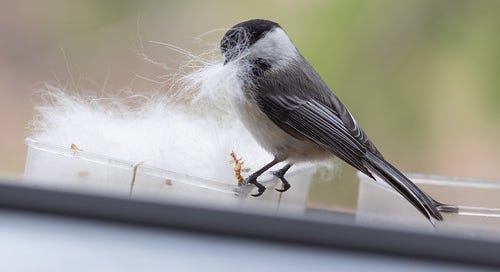(Listen to the radio version here.)
Most of the things I write, for this blog and my radio show/podcast, or for publication by others, go out into the world without my having any idea how they’ll land with readers and listeners. I occasionally hear from radio stations when listeners complain about the “liberal” or “woke” content of For the Birds. I’ve always been a strong environmentalist, which used to be a bipartisan thing but nowadays pretty much does translate to being a liberal, and I like being wide awake, so I never respond to those unless the complaint includes substantive arguments. When I discover or am alerted to a factual error, I do my best to publicly correct it as quickly as possible.
Some readers and listeners send me positive comments, which are extremely gratifying. But once in a while, something I write sets off someone’s ire. My recent blogpost and radio program titled “Setting out pet fur for birds is dangerous” elicited positive comments from a few people but was very strongly criticized in three emails from one blog reader.
I’d written the post after reading an Oklahoma birding listserv post by the wonderful conservationist Jerry Davis, and then an item on the Cornell Lab of Ornithology’s website, both mentioning an important 2025 U.K. study published in Science of the Total Environment. Researchers examining 103 nests of Great Tits and Eurasian Blue Tits found that the insecticides in flea and tick preventatives contaminated the fur incorporated into every one of the nests, and that the higher the amount of these pesticides in a nest, the fewer eggs produced and subsequently hatched, and the higher the chick mortality.
It was important for me to bring this study to people’s attention because I had personally recommended setting out pet fur in my 2006 book, 101 Ways to Help Birds, and I still provide that content on my webpage. I’ve also talked and written about how gratifying it is when birds use our pets’ fur for their nests. Now I know better, and I needed to set the record straight.
My critic jumped from one criticism to another, starting with questioning the validity of the study. She first argued that, as the scientists themselves mentioned in the paper, the strong correlation between the amount of pesticide in the nesting fur and lower nest success didn’t necessarily prove causation, jumping to conclude that this paper was an example of the “publish or perish” mentality that impels some researchers to publish misleading or even falsified data.
She clearly didn’t understand that a lot of important studies begin with some scientists establishing and publishing about a correlation, giving other scientists the starting point to discover the underlying mechanisms. I gave as an example Joe Hickey, who measured eggshell thickness in both contemporary Peregrine Falcon eggs and those of museum specimens collected before DDT was available to show that the reason the falcons were declining precipitously was almost certainly because something related to DDT was causing eggs to be too fragile to hatch. Hickey wasn’t a physiologist, but the powerful correlation he discovered gave the impetus to avian physiologists to determine the mechanism.

I said that had Hickey waited to publish anything until causation was established, we’d have seen a whole different spin on “publish or perish”—my big brother was one of the many kids who used to jump on their bikes and follow the DDT truck. Had we waited years longer to ban DDT use in the United States, even more little kids would have been exposed, and Peregrine Falcons, Bald Eagles, and other species already on the brink might have disappeared altogether.
She sort of explained why she was so upset about my post in the first place, writing that people might take my words:
a bit too far by not treating their pets with such chemicals in order to save the birds. We already have too many dogs suffering from heartworm. Tick bites can cause a variety of illness in pets and their owners.
But I had discussed giving my own dog Pip a flea-and-tick preventative.
I also discussed how valuable it had been to get my clothing treated before my trip to Guyana, noting that “climate change is making insect-borne diseases ever more prevalent.” Nowhere did I suggest that I or anyone else stop using these products for their pets or themselves. All I asked was that people dispose of pet fur and treated clothing in the garbage where nesting birds can’t get it. That seems like a pretty simple no-brainer.
I did mention that sarolaner, one of the active ingredients in the Simparica TRIO that I give Pip, is known to cause tremors, ataxia, and seizures in some dogs, but that warning is right on the box, and veterinarians avoid prescribing it for dogs who’d be most vulnerable to those neurologic side effects. My mentioning that at all was simply to suggest one possible reason why tiny, unfeathered nestlings might be vulnerable to something most dogs do fine with.
She didn’t answer a single one of my points in her third, and final, email. Instead, she changed tack yet again, now going after the journal Science of the Total Environment:
You’ve your opinions and I have mine.
However I would encourage you to examine these reports about the journal this study was published in.
She attached two too-tiny-to-read screen caps of LinkedIn posts about someone who’s name I couldn’t decipher even on my large computer monitor, a link to an article about a person faking peer reviews (a person not associated with this study), and a Wikipedia link about the journal itself that mentioned a couple of scandals having nothing to do with this paper or its authors.
I asked my environmental chemist and toxicologist husband Russ about Science of the Total Environment, which he said was a decent peer-reviewed journal with a long history (it was started in 1972), maybe second tier compared to Science, Ecology, and some other more prestigious journals but still very credible.
I’d already wasted over two hours of my finite, ever-shortening lifespan on this exchange without her acknowledging a single point I’d made, so I gave up.
I stand by every word of my original post and my conclusion. If your pets get flea and tick protection, please don’t set out their fur for nesting birds. That is all I have to say about that.








It's such a simple measure to avoid putting out fur from animals treated with flea and tick preventives that I can't see a reason to fuss over it. Plus, if you're so dedicated to providing nest materials, harvest fur from the times of year, (we have them up north,) that it has been a few months since they were given meds. Our dogs stop the meds in about November and aren't re-started until April The hair obtained from brushing them in March or April might not contain a harmful concentration for baby birds(?) Just a thought for any who think pet fur is essential for a nice nest.
Especially these days, there are far too many keyboard warriors who prefer to stir up trouble based on supposed “facts” that don’t align with the majority of scientific research. It’s a shame to attack you, who has done more for the avian world than just about anyone else in the world. I am in complete agreement with your statement that animal fur might be dangerous to birds or other animals. Your insightful and fact-based post helped well-meaning people understand the dangers of their actions. You are 100% right. There will always be that person who wants to pick a fight. Unfortunately, you have to take the brunt of her attempts to discredit you. That’s not going to happen here. This is your site!